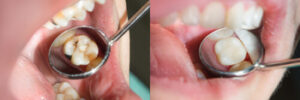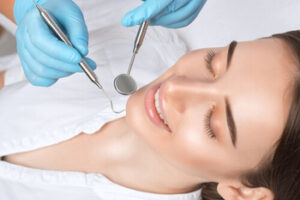If you’ve ever felt a dull ache near the back of your jaw or struggled with sore gums behind your molars, you’re not alone. Many people experience noticeable changes in comfort, chewing, and jaw pressure when their wisdom teeth begin to emerge. Understanding the difference before and after wisdom teeth removal helps you decide whether it’s time to consider treatment. Every person’s experience is different, but there are shared signs and outcomes worth exploring. You might be wondering how your daily routine or smile will change after the procedure. Let’s explore what really happens before and after wisdom teeth removal and how it can impact more than just your mouth.
What Are Wisdom Teeth and Why Do They Need to Be Extracted?
Wisdom teeth are often a turning point in many people’s oral health journey. While some individuals experience no issues, others face complications that can disrupt everyday comfort and dental function.
When Wisdom Teeth Start to Cause Trouble
For many, the four wisdom teeth begin to emerge during the late teen years or early adulthood. However, problems can arise when there isn’t enough room in the jaw to support them properly. This limited space can force them to erupt at odd angles or stay partially trapped under the gum, leading to impacted wisdom teeth. These impacted teeth often press against nearby teeth, affecting alignment and increasing discomfort. The pressure can interfere with normal chewing or brushing, making it harder to maintain oral hygiene.
Common Signs You Might Need Extraction
Some people notice swelling or tenderness at the back of the mouth as their wisdom teeth begin to move. In more advanced cases, this pressure can lead to severe pain that radiates across the jaw. Headaches and earaches are also common symptoms linked to this eruption. Infections can develop around the area where the tooth is trying to break through, especially if food and bacteria collect beneath the gums. When infection persists, the surrounding tissue may become inflamed, and daily activities such as eating or speaking can become more difficult.
Risks of Ignoring Problematic Wisdom Teeth

Extraction Can Prevent Further Issues
Removing wisdom teeth is often recommended to protect oral health in the long run. By taking them out before complications arise, dental professionals can help prevent crowding, infection, or damage to other teeth. Even if your wisdom teeth have erupted without discomfort, routine check-ups are essential. This allows your dentist to monitor how they are affecting surrounding areas and whether intervention is necessary. Proactive removal reduces the risk of future dental concerns and often leads to a smoother recovery.
When to Discuss Removal with Your Dentist
Not every person needs their wisdom teeth extracted, but regular assessments help determine the most suitable course of action. If you are experiencing discomfort, difficulty opening your mouth, or repeated infections in the back of the mouth, it may be time to explore removal. Your dentist will examine how the teeth are positioned and whether they pose any risk to your dental alignment or overall comfort. Acting early can make the teeth easier to remove and simplify the recovery process.
How Is the Wisdom Teeth Extraction Done?
Many people consider wisdom teeth extraction an important step in maintaining comfort and oral function. Knowing how the procedure works can make the experience feel more manageable and help ease common concerns.
Careful Assessment Before Beginning
Before starting, your dentist will assess your mouth using a visual exam and dental X-rays. This allows them to identify the position of each wisdom tooth and its relationship with nearby nerves, sinuses, or other structures. Depending on how the teeth are positioned, the dentist may recommend removing all at once or only the ones likely to cause trouble. This initial step ensures the wisdom tooth extraction procedure is tailored to suit your needs.
Anaesthetic Ensures a Smooth Experience
Once the planning stage is complete, the area is numbed with local anaesthetic. If multiple teeth are being removed or if the procedure is more complex, sedation may also be offered. Comfort is a top priority, and anaesthetic helps make sure the teeth removal process is as comfortable as possible. Patients stay awake unless additional sedation is used, but the area around the teeth is completely desensitised.
Accessing the Tooth Precisely
For partially erupted or impacted teeth, your dentist makes a small incision in the gum. If the tooth is still covered by bone, a small portion may be removed to allow access. Some teeth may need to be sectioned into smaller pieces, especially if they are angled or surrounded by dense tissue. Breaking them into pieces ensures a more controlled removal and protects nearby teeth from pressure during the extraction.
Tooth Removal and Site Cleaning
Once accessible, the wisdom tooth is gently lifted from the socket using dental tools. Each section is removed one by one until the entire tooth has been cleared. The site is then examined to make sure no fragments remain. The goal at this point in the wisdom tooth extraction process is to leave the area clean and ready to heal. A blood clot naturally begins to form in the socket, which protects the exposed tissue and supports recovery.
Closing the Gum Tissue
In some cases, especially after a more involved wisdom teeth surgery, dissolvable stitches may be placed to hold the gum in position. This helps the tissue remain stable as it heals and keeps food particles from entering the site. Once the area is cleaned and gauze is applied, you are closely monitored for a short time to ensure everything looks as expected before leaving the dental clinic.
If Multiple Wisdom Teeth Are Removed
Some patients choose to have all four removed in one visit. When this happens, the procedure is carefully planned so each tooth is removed safely and efficiently. Managing multiple extractions together can reduce the number of appointments and shorten the total healing time. The wisdom teeth removal surgery is performed in one session, but each tooth is still treated individually during removal.
Understanding each stage of the wisdom teeth removal process helps you feel informed and more at ease during your appointment.
What Steps Should You Take for Proper Aftercare Following Wisdom Teeth Removal?
Recovery after having your wisdom teeth removed can influence how well the area heals and how soon you feel back to normal. Following the right steps not only reduces discomfort but also lowers the risk of complications that could slow your progress.
Take Care with What You Eat
Eating the right foods makes a big difference in healing. Soft meals such as mashed vegetables, yoghurt, or soup are easier to manage and gentle on the area. Avoid using straws, as the suction can interfere with clot formation. It’s also wise to stay away from spicy foods during this period, as they can irritate the healing tissue. Chewing should be done on the opposite side to avoid putting pressure on the area where the wisdom teeth were removed.
Use Cold Compresses Early On
To help manage swelling, apply a cold compress to the outside of your cheek in intervals. Fifteen minutes on and fifteen minutes off during the first day can keep inflammation under control. This can also help reduce bruising and ease the general discomfort that sometimes follows the procedure. Continue this routine as recommended for the first day or two, depending on how your body responds.
Keep Up with Oral Hygiene Gently
Maintaining cleanliness is important, but should be done with care. You can start brushing your teeth the next day, making sure to avoid the area near the extraction sites. Use a soft-bristled toothbrush and rinse gently using salt water or mild mouthwash only if advised by your dentist. Be cautious with the movement of water in your mouth to prevent disturbing the healing process. This balance helps you stay fresh while giving the tissue the space it needs to recover.
Take Medications as Directed
Pain relief or anti-inflammatory medications may be suggested by your dentist to make your recovery more manageable. It’s important to follow their guidance closely, sticking to the exact dosage and timing. Avoid self-medicating or increasing the dose on your own. Consistent use during the initial recovery days can help you feel more comfortable and prevent inflammation from getting worse. Contact your clinic if you experience side effects or if the discomfort increases unexpectedly.
Rest Is More Important Than You Think
Giving your body time to rest will support a smoother recovery. Try to limit physical activity for the first day or two, and avoid bending over or lifting anything heavy. Keeping your head slightly elevated when lying down can help reduce pressure and keep swelling to a minimum. This extra rest allows your immune system to work efficiently and focus on healing the affected areas without added strain.
Know When to Check In
Not all symptoms are a cause for concern, but you should know what signs need attention. If bleeding continues beyond the expected window or if swelling increases significantly after the third day, reach out to your dentist. High fever, foul taste, or severe pain can be indicators that your healing is not progressing as expected. A quick check-in can help rule out complications and provide peace of mind.
Book Your Wisdom Teeth Consultation Without Delay

Note: Any surgical or invasive procedure carries risks. Before proceeding, you should seek a second opinion from an appropriately qualified health practitioner.
References
https://www.colgate.com/en-in/oral-health/wisdom-teeth/wisdom-tooth-extraction
https://www.ncbi.nlm.nih.gov/books/NBK279590/






